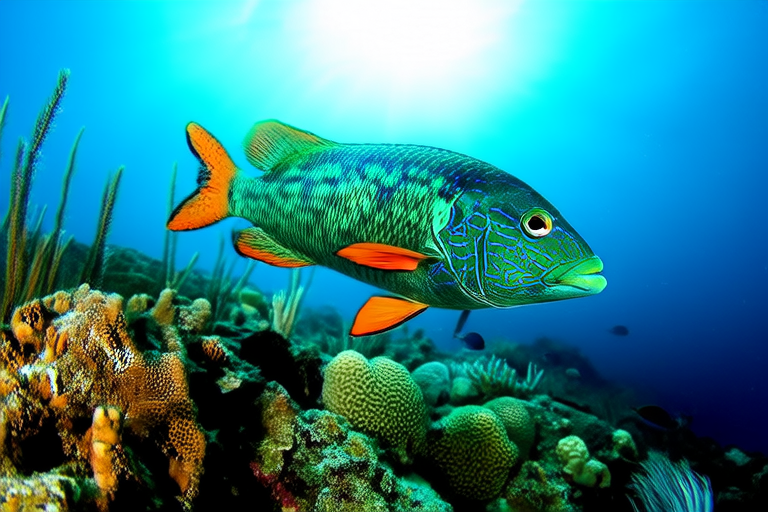Unveiling the Vibrant Life of Parrot Fish: Colors, Behavior, and Care Tips
The world of marine life is teeming with fascinating creatures, each with its own unique characteristics and behaviors. Among the most captivating are the parrot fish, known for their vibrant colors, interesting behaviors, and intricate social structures. This article delves into the stunning array of colors that parrot fish display, their intriguing behaviors, and essential care tips for those interested in keeping them as pets.
Colors of Parrot Fish: A Kaleidoscope Underwater
Parrot fish are renowned for their dazzling array of colors, which can range from bright reds and yellows to deep blues and greens. These hues serve multiple purposes in their natural habitat, contributing significantly to their survival and social interactions. The vivid colors act as a form of camouflage, blending in with the coral reefs and making it difficult for predators to spot them. Additionally, these colors play a crucial role in attracting mates and establishing dominance within their social groups.
During breeding season, male parrot fish often intensify their coloration to attract females, creating a visually striking spectacle. Their colors also help in identifying different species and distinguishing between males and females. For instance, the Queen parrot fish exhibits a striking blue coloration, while the Midnight parrot fish is characterized by its deep black hue. Understanding the significance of these colors enhances our appreciation of these remarkable creatures.
Behavior of Parrot Fish: Feeding Habits, Territoriality, and Communication
Parrot fish are active swimmers, and their behavior revolves around feeding, territory, and social interactions. They are primarily herbivorous, feeding on algae and other plant material found on coral reefs. Their unique beak-like mouths are adapted for scraping algae off rocks and coral, contributing to the maintenance of healthy reef ecosystems. This feeding habit not only sustains their diet but also helps in shaping the appearance of the reefs.
Parrot fish are territorial creatures, particularly during breeding seasons. Males will establish and defend territories to attract females and ensure the survival of their offspring. They use various methods to communicate, including body movements and sounds produced by grinding their pharyngeal teeth. These sounds can be heard through the water and serve as a means of attracting mates or warning intruders away from their territories.
In addition to their territorial nature, parrot fish exhibit complex social behaviors. They often form schools, which provide protection against predators and facilitate finding food. Within these schools, there is a hierarchy, with dominant individuals having priority access to resources. This social structure ensures the survival of the group and contributes to the overall stability of the reef ecosystem.
Care Tips for Keeping Parrot Fish as Pets
For those interested in keeping parrot fish as pets, understanding their specific needs is crucial for ensuring their well-being. Here are some comprehensive care tips:
Tank Setup
A properly set up aquarium is essential for the health and happiness of parrot fish. They require a large tank, ideally over 100 gallons, to accommodate their size and swimming patterns. The tank should be equipped with a robust filtration system to handle the biological load and maintain water quality. Adequate lighting is necessary to simulate natural conditions and promote the growth of algae for the fish to feed on.
Incorporating plenty of hiding spots and caves within the tank provides parrot fish with security and reduces stress. Live rock and coral can enhance the tank’s aesthetic appeal and offer additional surfaces for algae growth. Regular water changes and maintenance of stable water parameters are vital to prevent disease and ensure optimal living conditions.
Diet
Parrot fish are herbivores, so their diet should consist primarily of algae and plant-based foods. In the absence of natural algae, they can be fed a variety of commercially available algae wafers, spirulina flakes, and seaweed sheets. Supplementing their diet with occasional treats like blanched vegetables or high-quality pellets can provide essential nutrients. It is important to avoid overfeeding, as excess food can lead to poor water quality and health issues.
Feeding should be done at consistent times to establish a routine. Providing a varied diet ensures that parrot fish receive all the necessary nutrients for their growth and overall health. Regular observation of their eating habits can help identify any potential dietary deficiencies or health problems.
Health Monitoring and Compatibility
Regular health checks are essential for maintaining the well-being of parrot fish. Look out for signs of illness such as loss of appetite, abnormal swimming patterns, or visible lesions. Early detection and prompt treatment can prevent the spread of diseases within the tank. Quarantine new additions to the aquarium for several weeks to monitor their health before introducing them to the main tank.
Compatibility with other tank inhabitants is another critical factor. Parrot fish can be aggressive towards smaller fish, especially those with similar body shapes. Therefore, it is advisable to house them with larger, more robust species that can hold their own. Compatible tankmates include tangs, surgeonfish, and triggerfish. Avoid housing them with delicate corals or invertebrates, as their feeding habits may cause damage.
By understanding and addressing the specific needs of parrot fish, aquarists can create a thriving environment that mimics their natural habitats. This not only enhances the fish’s quality of life but also adds a vibrant and dynamic element to any aquarium setup.
Conclusion
The parrot fish are truly remarkable creatures, showcasing a kaleidoscope of colors, intriguing behaviors, and complex social structures. From their vibrant hues aiding in survival and social interactions to their active feeding habits and territorial nature, every aspect of their life is fascinating. By providing proper care, including appropriate tank setups, balanced diets, and compatible tankmates, aquarists can enjoy the beauty and vitality of these captivating fish. Embracing the challenges and rewards of keeping parrot fish as pets can lead to a rewarding and enriching experience for both the fish and the aquarist.
